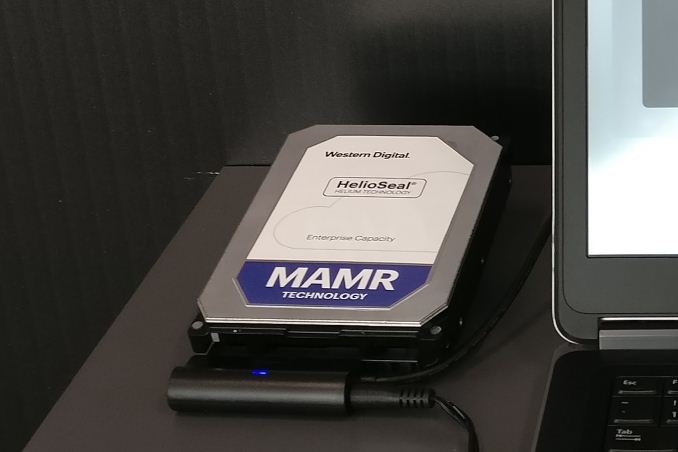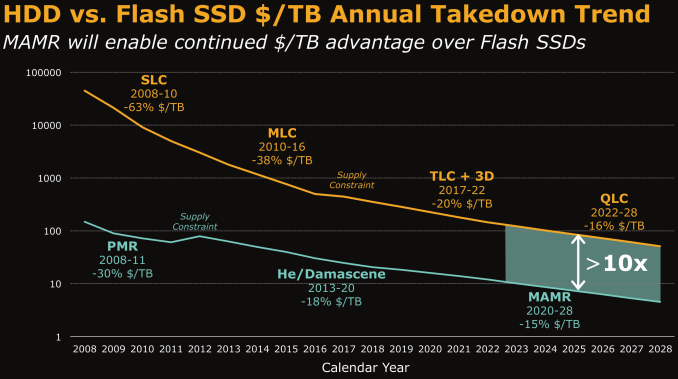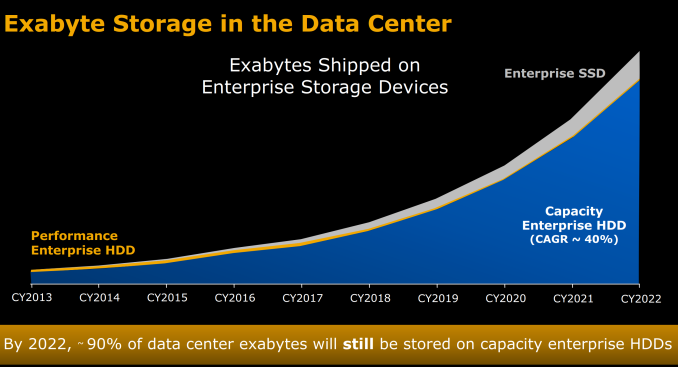Western Digital Stuns Storage Industry with MAMR Breakthrough for Next-Gen HDDs
by Ganesh T S on October 12, 2017 8:00 AM EST
Yesterday, Western Digital announced a breakthrough in microwave-assisted magnetic recording (MAMR) that completely took the storage industry by surprise. The takeaway was that Western Digital would be using MAMR instead of HAMR for driving up hard drive capacities over the next decade. Before going into the specifics, it is beneficial to have some background on the motivation behind MAMR.
Hard drives may be on the way out for client computing systems, but, they will continue to be the storage media of choice for datacenters. The Storage Networking Industry Association has the best resources for identifying trends in the hard drive industry. As recently as last year, heat-assisted magnetic recording (HAMR) was expected to be the technology update responsible for increasing hard drive capacities.

Slide Courtesy: Dr.Ed Grochowski's SNIA 2016 Storage Developer Conference Presentation
'The Magnetic Hard Disk Drive: Today’s Technical Status and Its Future' (Video, PDF)
Mechanical Hard Drives are Here to Stay
One of the common misconceptions amongst readers focused on consumer technology relates to flash / SSDs rendering HDDs obsolete. While using SSDs over HDDs is definitely true in the client computing ecosystem, it is different for bulk storage. Bulk storage in the data center, as well as the consumer market, will continue to rely on mechanical hard drives for the foreseeable future.
The main reason lies in the 'Cost per GB' metric.
Home consumers are currently looking at drives to hold 10 TB+ of data, while datacenters are looking to optimize their 'Total Cost of Ownership' (TCO) by cramming as many petabytes as possible in a single rack. This is particularly prevalant for cold storage and archival purposes, but can also expand to content delivery networks. Western Digital had a couple of slides in their launch presentation yesterday that point towards hard drives continuing to enjoy this advantage, thanks to MAMR being cost-effective.
Despite new HDD technology, advancements in solid state memory technology are running at a faster pace. As a result SSD technology and NAND Flash have ensured that performance enterprise HDDs will make up only a very minor part of the total storage capacity each year in the enterprise segment.
The projections presented by any vendor's internal research team always need to be taken with a grain of salt, but given that SanDisk is now a part of Western Digital the above market share numbers for different storage types seem entirely plausible.
In the next section, we take a look at advancements in hard drive technology over the last couple of decades. This will provide further technical context to the MAMR announcement from Western Digital.












127 Comments
View All Comments
DanNeely - Thursday, October 12, 2017 - link
This's a pleasant surprise (cheaper bulk storage is always a win). Projections I'd seen from a year or two ago were projecting a mid 2020's point for flash becoming cheaper per TB than HDDs. I assume the high expected cost for HAMR was probably a major driving factor in those projections. If MAMR really will be as cheap to implement as current PMR solutions it's good news all around.MajGenRelativity - Thursday, October 12, 2017 - link
Agreedjjj - Thursday, October 12, 2017 - link
WD used to lie a lot less than others but those HDD vs SSD projections are hilarious, new CEO ,new habits i suppose.SSDs will go after nearline soon enough as they'll need to do that to offload all the bits produced.
Anyway, interesting tech but too late to matter much and that's a pity.
melgross - Thursday, October 12, 2017 - link
It's going to take a heck of a long time before SSDs come close to the costs of HDD.While HDDs seem to have newer tech to enable more storage in the same space, SSD is relying on multilayering, which is now 64, but moving to 72. The idea of using smaller process diminution has ended, unless some unknown breakthrough occurs, which we can't expect, because there's nothing known to have us expect one. How many layers can be made? At some point, it won't be possible to go any higher.
But MAMR was understood to be a slight possibility, and WD has made that breakthrough. There's no reason to believe that the 40TB by 2025 shouldn't be believed since preproduction sampling will be next year, and production delivery will be in 2019. That's pretty quick.
Lolimaster - Thursday, October 12, 2017 - link
But 40TB on the top of the line for 2025 is still too low, considering near 10years of PMR stagnation.HAMR was supposed to give us 15-20TB by now, up to 50TB by 2020-2021 and up to 100TB in 2025.
melgross - Thursday, October 12, 2017 - link
Who are you to say it's too low? Are you doing research in this area to know that? Or do you just read articles on it and complain because it's not moving fast enough for you?AnnonymousCoward - Thursday, October 12, 2017 - link
Samsung says 128TB SSD in 2019.beginner99 - Friday, October 13, 2017 - link
The issue with SSDs is that there already is a shortage of flash. Flash is a semi-conductor and hence manufacturing is a bottleneck. Unless a significantly better alternative to flash is found, ssd will remain niche in terms of total storage amounts.someonesomewherelse - Saturday, October 14, 2017 - link
Cartel agreements you mean.shabby - Thursday, October 12, 2017 - link
And I'm sure when these are released they'll still be the same size like the current drives so wd can keep milking everyone.